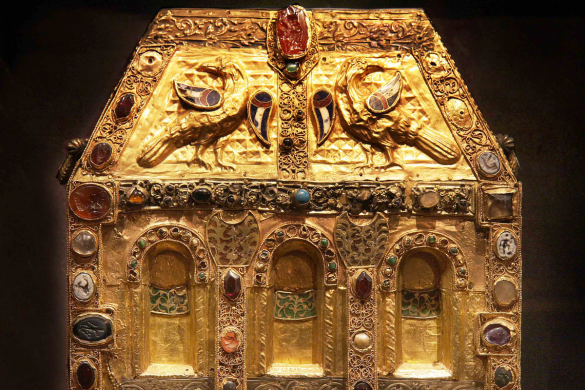This is a popular stop for pilgrims traveling the Way of St. James to Santiago de Compostela. The main draw for medieval pilgrims at Conques were the remains of St. Foy, a young woman martyred during the fourth century. The relics of St. Foy arrived in Conques through theft in 866. After unsuccessful attempts to acquire the relics of St. Vincent of Saragossa and then the relics of St. Vincent Pompejac in Agen, the abbey authorities set their sights on the relics of St. Foy at the ancient St. Faith’s Church, Sélestat. The Conques abbey opened a priory next to the shrine in Sélestat. A monk from Conques posed as a loyal monk in Agen for nearly a decade in order to get close enough to the relics to steal them.

There are 212 columns with decorated capitals: palm leaves, birds, symbols, biblical monsters and scenes from the life of St. Foy. The capitals functioned as didactic picture books for both monks and pilgrims. Traces of colour are still visible.
Light filters into Conques through the large aisle and smaller gallery windows. The ambulatory allowed pilgrims to glimpse into the sanctuary space through a metal grill made of donated shackles from former prisoners who attributed their freedom to St. Foy. The chains also have a number of symbolic meanings – reminding pilgrims of the ability of St. Foy to free prisoners and the ability of monks to free the penitent from the chains of sin. As stories spread pilgrimage traffic increased.
There is little exterior ornamentation on Conques except necessary buttresses and cornices. The exception to this is the Last Judgment tympanum located above the western entrance.
![]()

Images of doom were used to remind pilgrims of the purpose of their pilgrimage. The tympanum depicts Christ in Majesty presiding over the judgment of the souls of the deceased. The cross behind Christ indicates he is both Judge and Saviour. Archangel Michael and a demon weigh the souls of the deceased on a scale. The righteous go to Christ’s right while the dammed go to Christ’s left where they are eaten by a Leviathan and excreted into Hell. The tortures of Hell are vividly depicted including poachers being roasted by the very rabbit they poached from the monastery.
 The tympanum also provides an example of cloister wit. A bishop who governed the area of Conques but was not well liked by the monks of Conques is depicted as being caught in one of the nets of Hell.
The tympanum also provides an example of cloister wit. A bishop who governed the area of Conques but was not well liked by the monks of Conques is depicted as being caught in one of the nets of Hell.
The virtuous are depicted less colourfully. The Virgin Mary, St. Peter and the pilgrim St. James stand on Christ’s left. Above their heads are scrolls depicting the names of the Virtues. Two gable shaped lintels act as the entrance into Heaven. In Heaven Abraham is shown holding close the souls of the righteous. A pudgy abbot leads a king, possibly Charlemagne, into heaven. St. Foy is shown on the lower left kneeling in prayer and being touched by the outstretched hand of God. Particularly interesting are carvings of the “curieux” (the curious ones), forerunners of the World War II-era cartoon image known as Kilroy, who peek over the edges of the tympanum. The tympanum was inspired by illuminated manuscripts and would have been fully colored, small traces of the color survive today.
Treasury. Conques is the home of many spectacular treasures. One of which is the famous ‘A’ of Charlemagne. The legend is that Charlemagne had twenty-four golden letters created to give to the monasteries in his kingdom. Conques received his ‘A’ indicating that it was his favorite. This is only legend; while the “A” exists it dates to circa 1100 and no other pieces of Charlemagne’s alphabet have ever been found. Conques is also home to an arm of St. George the Dragon Slayer. It is claimed that the arm at Conques is the arm with which he actually slew the dragon.
The golden statue reliquary of St. Foy was the main goal of the pilgrims who came to Conques. The head of the reliquary contains a piece of skull which has been authenticated as a fifth-century Roman head. As miracles reportedly increased, the gold crown, earrings, gold throne, filigree work and cameos and jewels, mostly donations from pilgrims, were added. In the fourteenth-century a pair of crystal balls and their mounts were added to the throne. Silver arms and hands were added in the sixteenth century. In the eighteenth-century bronze shoes and bronze plates on the knees were added.


The St. Foy abbey-church was added to the UNESCO World Heritage Sites in 1998, as part of the camino.